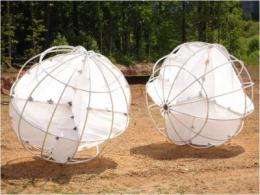On a roll: Designing the next rover to explore Mars

The concept of a wind-powered vehicle that can be used to explore the surface of Mars - a so-called "tumbleweed rover" that would roll over the surface of Mars like a tumbleweed - has been around for more than 10 years, but so far there has been no consensus on exactly what that vehicle should look like. Now researchers from North Carolina State University have developed a computer model that allows engineers to test the attributes of different vehicle designs. This will allow researchers to select the best design characteristics before spending the time and money necessary to create prototypes for testing in real-world conditions.
"We wanted a way to determine how different tumbleweed rover designs would behave under the various conditions that may be faced on the Martian surface," says Dr. Andre Mazzoleni, an associate professor of mechanical and aerospace engineering at NC State and co-author of a paper describing the research. "The model that we've developed is important, because it will help NASA [the National Aeronautics and Space Administration] make informed decisions about the final design characteristics of any tumbleweed rovers it ultimately sends to Mars."
The computer model developed at NC State determines how tumbleweed rover designs will function, based on their various design characteristics. For example, the model can show how a rover's diameter, elasticity and overall mass will affect its ability to navigate the Martian surface successfully.
NASA's Jet Propulsion Laboratory and Langley Research Center are both pursuing the idea of sending tumbleweed rovers to Mars - but researchers are still exploring various options for exactly how the rovers should be designed. "We're optimistic that our model can serve as a mission design tool that NASA can use to choose appropriate design parameters," Mazzoleni says.
"You can't just build hundreds of different rover designs to see what works - it's too expensive," says Alexandre Hartl, a Ph.D. student at NC State who co-authored the paper. "This model allows us to determine which designs may be most viable. Then we can move forward to build and test the most promising candidates."
And the model doesn't just test different rover designs in a stable environment. The model is flexible enough to allow researchers to look at how various designs would perform under different wind conditions and in different terrains - from Martian rock fields to craters and canyons. This is important, because the surface of Mars is marked by significant changes in landscape.
More information: The research, "Dynamic Modeling of a Wind-Driven Tumbleweed Rover Including Atmospheric Effects," was funded by NASA and the North Carolina Space Grant Consortium. The paper was published online June 1 by the Journal of Spacecraft and Rockets.
Provided by North Carolina State University



















